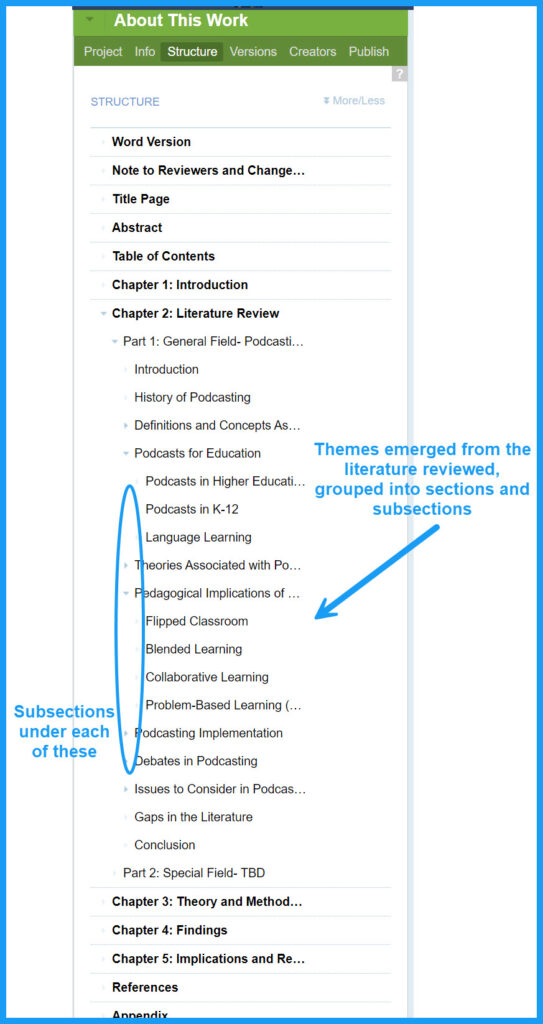Submitting, Reviewing, and Revising a Milestone
Select a button to view more details
Throughout the EDS we ask for certain formatting to be present. Some formatting we don’t require early on, but highly recommend it.

Prior to submitting a milestone, complete a self-assessment using the Milestone Formatting, Structure, and Copy-Editing Checklist. See also Dissertation Structure FAQ

REQUIREMENTS: Submission Formats: CGScholar, Word, and PDF
The majority of action items and deliverables associated with these courses and your milestones will take place within the CGScholar platform, but you should maintain a parallel Word version throughout the process.
See also the Work Submission and Review process web page that includes very specific instructions.
- Admin Updates: CGScholar
- Works for Peer Review: CGScholar with sections to align with the approved Graduate College format, attach a Word document to the first section (called Word Version)
- Advisor and Committee Review: Word document in the approved Graduate College format, attached to the Scholar submission
- Final Deposit Departmental and Thesis Office Review: PDF
REQUIREMENTS: Word and Scholar Versions and Titles
As stated above, you must submit everything in both Scholar and Word. The Word document is attached to the Scholar version in a “section” at the top (see the Structure/Headings section for more details) called Word Version.
Title
- CGScholar Title: Work Type and a brief, yet descriptive title (i.e. General Field: Multiliteracies)
- Avoid using the “subtitle” feature, as we can’t see that unless we are in preview/view in browser mode.
- Word version of the work filename: Author’s Name, Work Type, brief, yet descriptive title, and current revision date (i.e. John Smith_General Field_Multiliteracies_20221019)
- When adding the Word document to your Scholar project, either repeat the filename as the caption or leave the caption blank (which would show the filename by default). The goal is that we need to easily see the full filename without opening it to see the last revision date.
Dissertation Manuscript Title Page – this is the center where you indicate your degree

REQUIREMENTS: Basic Work Structure/Headings
Refer to each milestone web page for specific requirements and any additional structural elements.
The Graduate College Word Document format is required at each step.
Structure/Headings
- The first section in CGScholar is called: Word Version and attach the Word file within that section (and place name the Word document per the instructions above, and update the filename with each revision)
- Second section in Scholar/First in Word is Note to Reviewers and Change Notes; maintain this throughout the process. Change notes should be specific enough that reviewers can easily identify the changes in your text, but you don’t need to articulate every single change. (don’t say “I made changes based on peer feedback.” Instead, you could say, “Expanded on the strengths and weaknesses of the selected methodology by citing 4 more sources.)
- The subsequent sections should follow the Graduate College Format and our examination guidelines. Refer to each milestone for specific requirements
- Title Page
- Abstract (placeholder during early milestones)
- Table of Contents (may be a placeholder during early milestones)
- Chapter 1: Introduction (placeholder up until preliminary exam manuscript)
- Chapter 2: Literature Review (by the methods and prelim this will become a single literature review without the two parts specifically mentioned)
- Part 1: Genera Field: [Brief Title], with relevant subsections, such as Introduction, Theories, Themed sections (with actual section headers and subheaders), Gaps in the Literature, Conclusions, etc.
- Part 2: Special Field: [Brief Title], with relevant subsections, such as Introduction, Theories, Themed sections (with actual section headers and subheaders), Gaps in the Literature, Conclusions, etc.
- Chapter 3: Theory and Methodology, with relevant subsections (i.e. theoretical foundation, research questions, logic model, methodology design, implementation plan, etc. (placeholder until you arrive at that stage)
- Chapter 4: Findings, again, with relevant subsections (placeholder until you arrive at that stage)
- Chapter 5: Implications and Recommendations, again, with relevant subsections (placeholder until you arrive at that stage)
- References (maintain a single references section, not distinct ones for each milestone)
- Appendix, including data collection instruments, IRB materials, etc.
Sample Structure (CGScholar View)

Indenting and Moving Sections in Scholar
To indent in Scholar, you need to click on the + icon next to the section header within the Structure tool and drag and drop it to the right, under the desired parent section. You use this same icon to move sections up and down.
Resource: Writing Guide